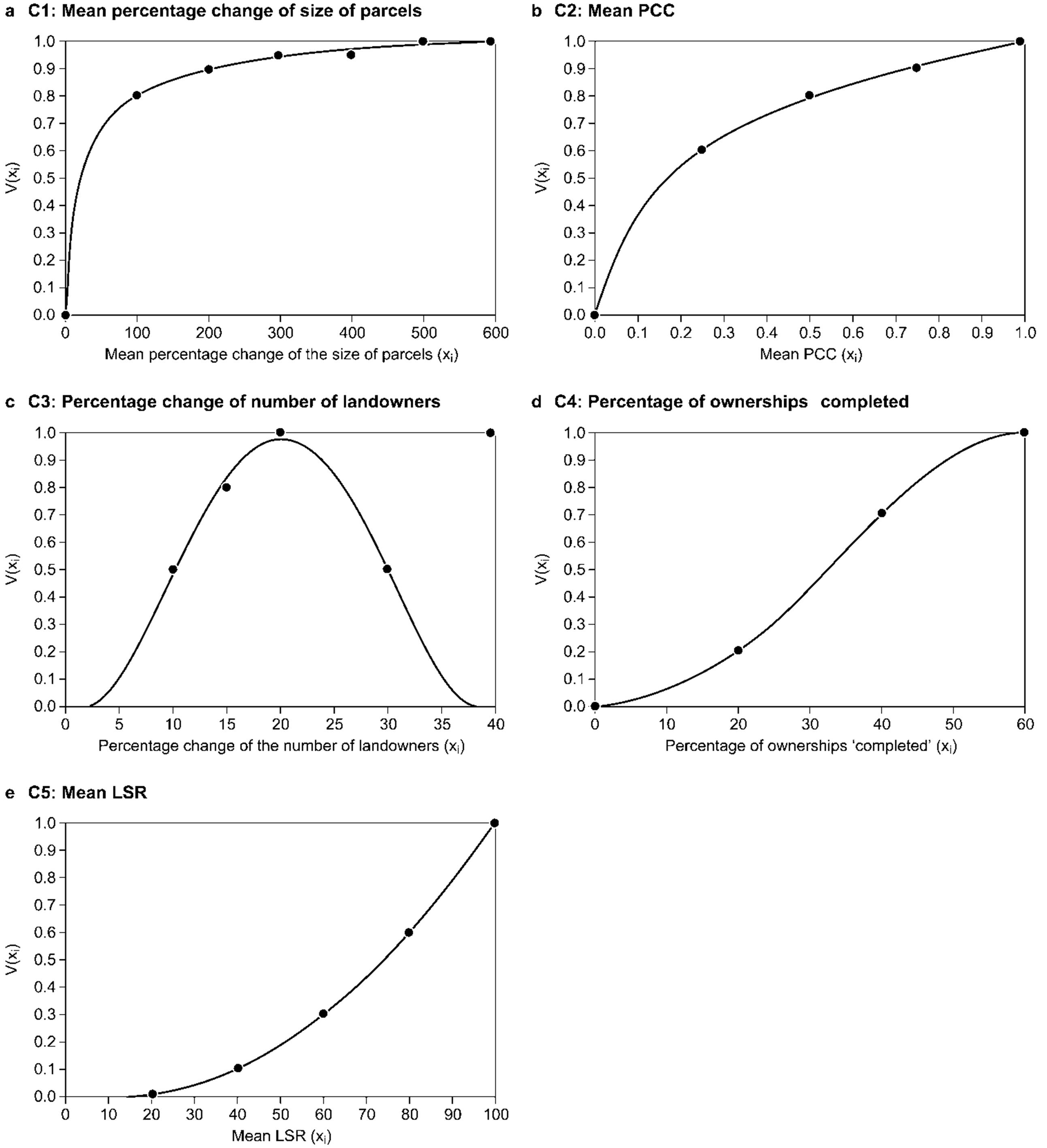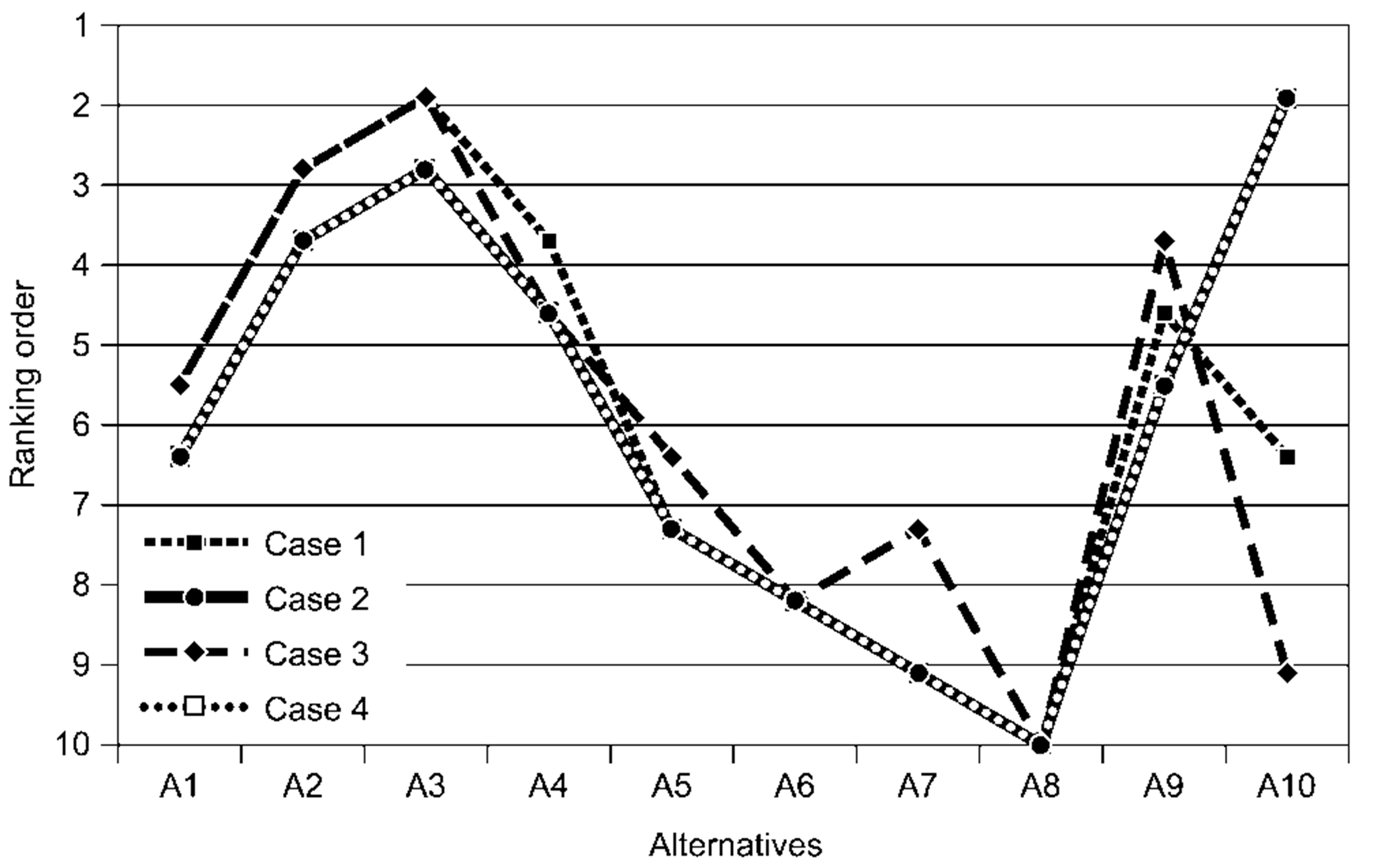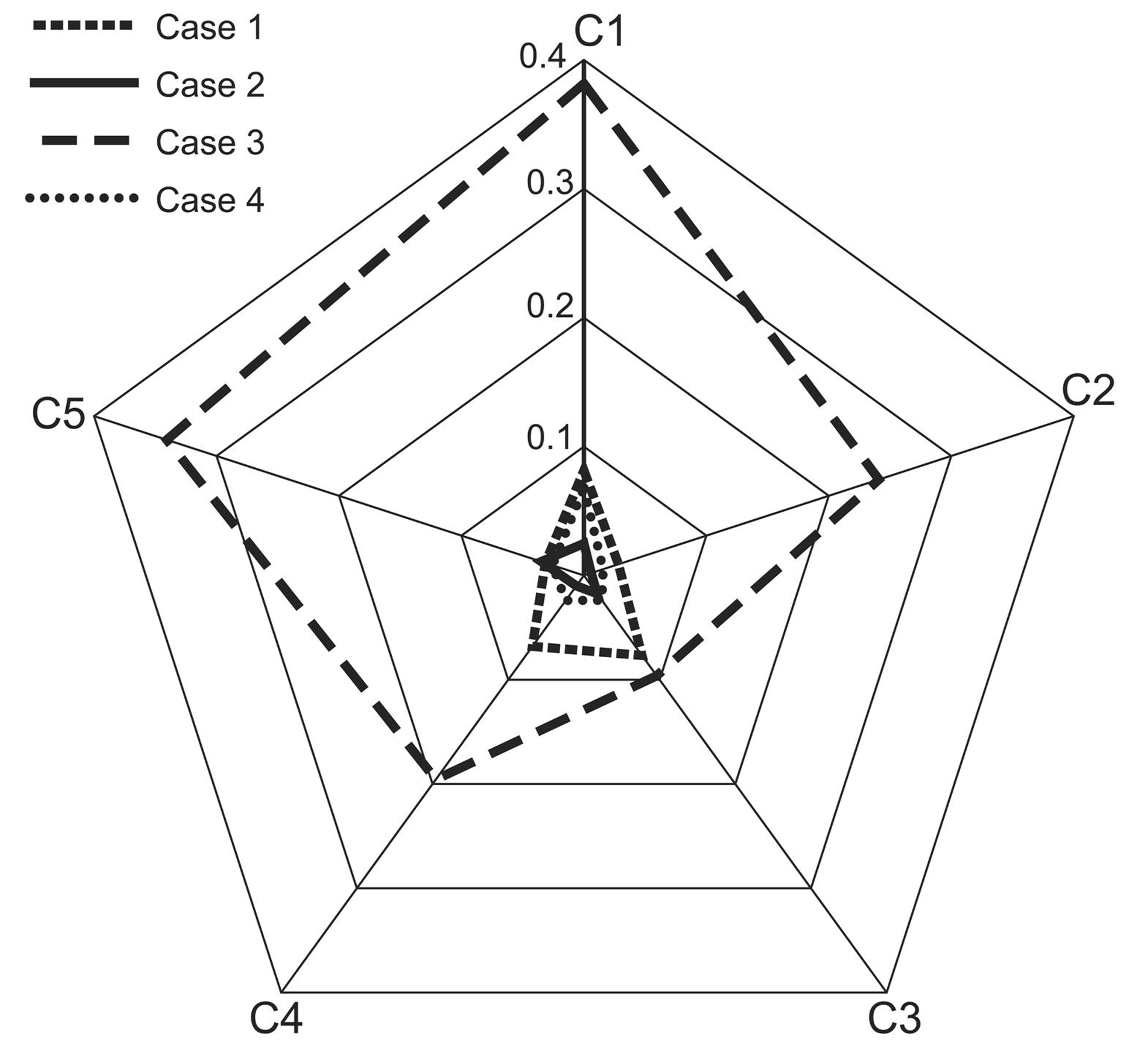The selection of the appropriate criteria begins with the definition of a hierarchical objective tree specified via the goal, aims and objectives of the land consolidation problem [
32]. Thereafter, a specific land redistribution objective tree can be formulated (
Figure 2) which contains the aims, objectives and the corresponding criteria/attributes, which can be used in the evaluation of the alternative land redistribution plans.
Whilst
Figure 2 shows nine possible criteria, Demetriou
et al. [
32] suggest that only the following five criteria are required: the mean size (as a percentage change before and after applying a solution) of the new parcels (C1); the mean parcel concentration coefficient (C2); the change (as a percentage) in the number of landowners (C3); the percentage of ownerships “completed” involving the percentage of ownerships that had less than the minimum size limit provided by legislation and “complete” to reach that minimum limit (C4); and the mean landowner satisfaction rate (C5). Both the PCC and LSR are new concepts, which are explained in more detail below.
Figure 2.
The objective tree for the land redistribution problem.
2.1.1. Parcel Concentration Coefficient (PCC)
A basic measure of spatial dispersion is standard distance which is the spatial equivalent of the standard deviation, showing how locations or points are scattered around the spatial mean [
33,
34]. The spatial mean or mean center of gravity is an important spatial statistical measure of central tendency which indicates the average location of a set of points defined in a Cartesian coordinate system. Thus, standard distance measures the degree to which parcels (or more precisely the centroids of parcels) are concentrated or dispersed around their geometric mean. Although, in practice, the dispersion of holdings is dependent on the location of the farmstead or the village where the farmer resides, and in this case transport distances could be calculated based on some assumptions [
21], the extra information needed is usually not available, so the mean center of parcels of a holding is a proxy criterion that gives an adequate representation of the dispersion before and after land consolidation.
An extension of both statistics is the weighted mean center and the weighted standard distance where centroids may have different attribute values representing the different sizes or land values of each parcel. For instance, if the largest parcels of a holding are very much dispersed in terms of location, this may have greater negative effects on production, productivity, labor and hence the income of farmer, than if the smaller parcels are dispersed [
19]. Thus, the weighted mean center of a holding is a better indicator than the simple mean center because it reflects not only the spatial dispersion of parcels but also the agricultural importance of each parcel.
Expressing these spatial statistics in the context of land consolidation, the mean center of the parcels of a holding can be expressed as:
where
xhmc and
yhmc are the co-ordinates of the mean center of the holding;
xi and
yi are the co-ordinates of the centroid of parcel
i; and
n is the number of parcels belonging to a holding. The weighted mean center of a holding can be calculated in a similar way as:
where
xwhmc and
ywhmc are the co-ordinates of the weighted mean center of the holding and
wi is the weight of each parcel
i. From these quantities, the dispersion of parcels (
DoP) and the weighted version of
DoP can be calculated as:
where both measures have been utilized previously by Tourino
et al. [
19]. However, the disadvantage of these measures is that they may vary across an unlimited range of values with no explicit extreme values, which renders interpretation difficult. In this research, a new indicator is developed called the parcel concentration coefficient (
PCC) for each holding which is measured on a scale between −1 and 1. A value of zero indicates no change in the dispersion of a holding’s parcels before and after land consolidation. The value of +1 refers to the situation of “perfect concentration” while −1 represents the “worst concentration”. The
DoP can be calculated for each holding twice,
i.e., before (
DoPb) and after (
DoPa) land consolidation and then combined to calculate the PCC for three situations:
If DoPb = DoPa then PCC = 0 and the dispersion of parcels has not changed.
In this situation, land consolidation has not achieved any concentration of parcels for the holding concerned independently of the number of new parcels allocated to a landowner (n') or the number of original parcels owned by the landowner (n).
If
DoPb >
DoPa the
PCC can be expressed as:
In this situation, an improvement in the dispersion of parcels has occurred. The maximum value of 1 means that parcels have been concentrated after land consolidation into a single parcel, i.e., n' = 1 and perfect concentration has been achieved. This happens when the DoPa equals 0 and consequently n' = 1. The numerator in Equation (5) represents the proportional change of dispersion before and after land consolidation of a holding. The denominator, i.e., n', adjusts the proportional change in dispersion (the level of concentration) since the PCC increases as n' decreases. In other words, the higher n', the less the concentration of new parcels and hence PCC reduces towards a value of zero.
If
DoPb <
DoPa, then the
PCC is expressed as:
In this situation, deterioration in the dispersion of parcels has occurred. This may occur when either n' is greater than n (which is a very rare case) and/or when the parcels have been allocated at greater distances. The extreme value of −1 means that the concentration of parcels after land consolidation has worsened independent of the number of new parcels allocated since the basic aim of concentrating parcels via land consolidation has completely failed. This happens when the DoPb equals 0 and consequently n = 1. The denominator n adjusts the proportional change in dispersion, i.e., the level of concentration, since the PCC increases as n increases. In other words, the greater the value of n, the less extreme the difference (before and after a project) in parcel concentration and hence PCC reduces towards zero because the dispersion was already poor.
2.1.2. Landowner Satisfaction Rate (LSR)
The landowner satisfaction rate (
LSR) is an indicator that captures the satisfaction of the landowners with regard to their preferences in terms of the location of their new parcels. It is based on the parcel priority index (
PPI) introduced in Demetriou
et al. [
8], which ranks the preferences of the landowners regarding the locations of the new parcels they wish to receive. The calculation of the
LSR involves determining which preferences of each landowner have been satisfied and assigns a proportional percentage of satisfaction (called the partial satisfaction rate,
PSR) to each new parcel depending on the ranking of the preference satisfied, with a maximum of 100%. A critical point in this process is that the original parcels of a landowner (
n), which are already in preference ranking order, are divided into two parts. The first covers the situation up to
n' whilst the other part covers the situation for the rest of the parcels,
i.e., from
n−
n'. Thus, if a new parcel falls in the first part, the PSR will be 100% but if it falls in the second part, then the PSR is assigned proportionally,
i.e., reduced, depending on
n and
n′. This can be expressed mathematically as follows:
If
n ≥
n' then the
PSR for each new parcel
i allocated to a landowner can be calculated as follows:
where
mi is a variable that takes into account the number of parcels originally owned by a landowner (
n) and the rank order of the preference of each original parcel
i (
ROi), and
P is a linear function that expresses decreasing satisfaction for each landowner. The two variables,
mi and
P are computed as follows:
Maxmi is the
mi value assigned to those new parcels that fall in the first part of original parcels as explained earlier. In this case, the parameter
ROi in Equation (8) is replaced by the number of new parcels (
n') as follows:
P is a constant percentage for the redistribution of each holding which is calculated based on the two parts mentioned earlier. In particular, the parcels that belong in the first part count as one sub-part whilst the parcels that belong in the second part count as a separate sub-part. Thus,
P results by dividing 100% by the total number of sub-parts which always equals
n−n'+1. Therefore,
P can be computed as:
Combining Equations (8) and (10) yields:
The total
LSR for each landowner
j is then calculated as the mean value of the
PSR:
Similarly, the average
LSR for the whole land consolidation area,
i.e., the whole project, can be calculated as the mean
LSR of all landowners (
l) who received property in the plan as follows:
The above assumptions become clearer by utilizing an example for calculating
PSR and
LSR. An example is provided in
Table 1 which involves a landowner who originally had five parcels (
i.e.,
n = 5) and after land consolidation receives 1, 2 or 3 parcels (
i.e.,
n' = 1 to 3). Each cell of the table contains the PSR value for each combination of
n and
n'.
Table 1.
An example for the calculation of the partial satisfaction rate.
Table 1.
An example for the calculation of the partial satisfaction rate.
| | Number of New Parcels (n') Allocated to the Landowner |
|---|
| n | 1 | 2 | 3 |
|---|
| 1 | maxM × P = 5× 20 = 100% | maxM × P = 4× 25 = 100% | maxM × P = 3× 33.33 = 100% |
| 2 | M2 × P =(5 – 2 + 1)× 20 = 80% | maxM × P = 4× 25 = 100% | maxM × P = 3× 33.33 = 100% |
| 3 | M3 × P = (5 – 3 + 1)× 20 = 60% | M3 × P = (5 – 3 +1 )× 25 = 75% | maxM × P = 3× 33.33 = 100% |
| 4 | M4 × P = (5 – 4 + 1)× 20 = 40% | M4 × P = (5 – 4 + 1)× 25 = 50% | M4 × P = (5 – 4 + 1)× 33.33 = 66.66% |
| 5 | M5 × P = (5 – 5 + 1)× 20 = 20% | M5 × P = (5 − 5 + 1)× 25 = 25% | M5 × P = (5 – 5 + 1)× 33.33 = 33.33% |
For example, if a landowner has been allocated one parcel (i.e., first column) in the same location as its fourth preference (i.e., fourth row), then the PSR and hence the LSR (because n' = 1) is 40%. Similarly, if the landowner has been allocated two parcels (i.e., second column), say in the same location as the first (i.e., first row) and fourth preference (i.e., fourth row), then the PSR is 100% and 50% for the location of the first parcel and second parcel, respectively. In this case, the average LSR is calculated as 75%.
































